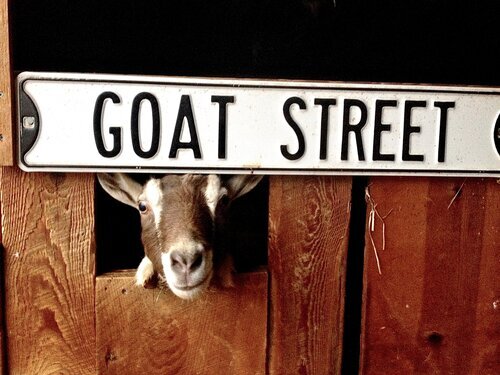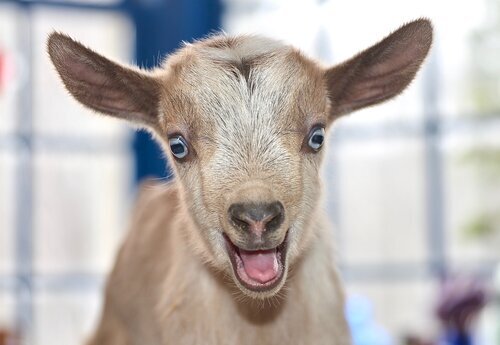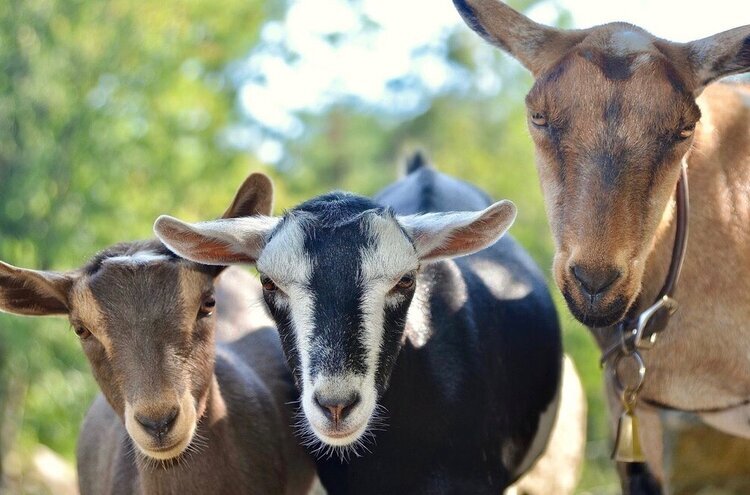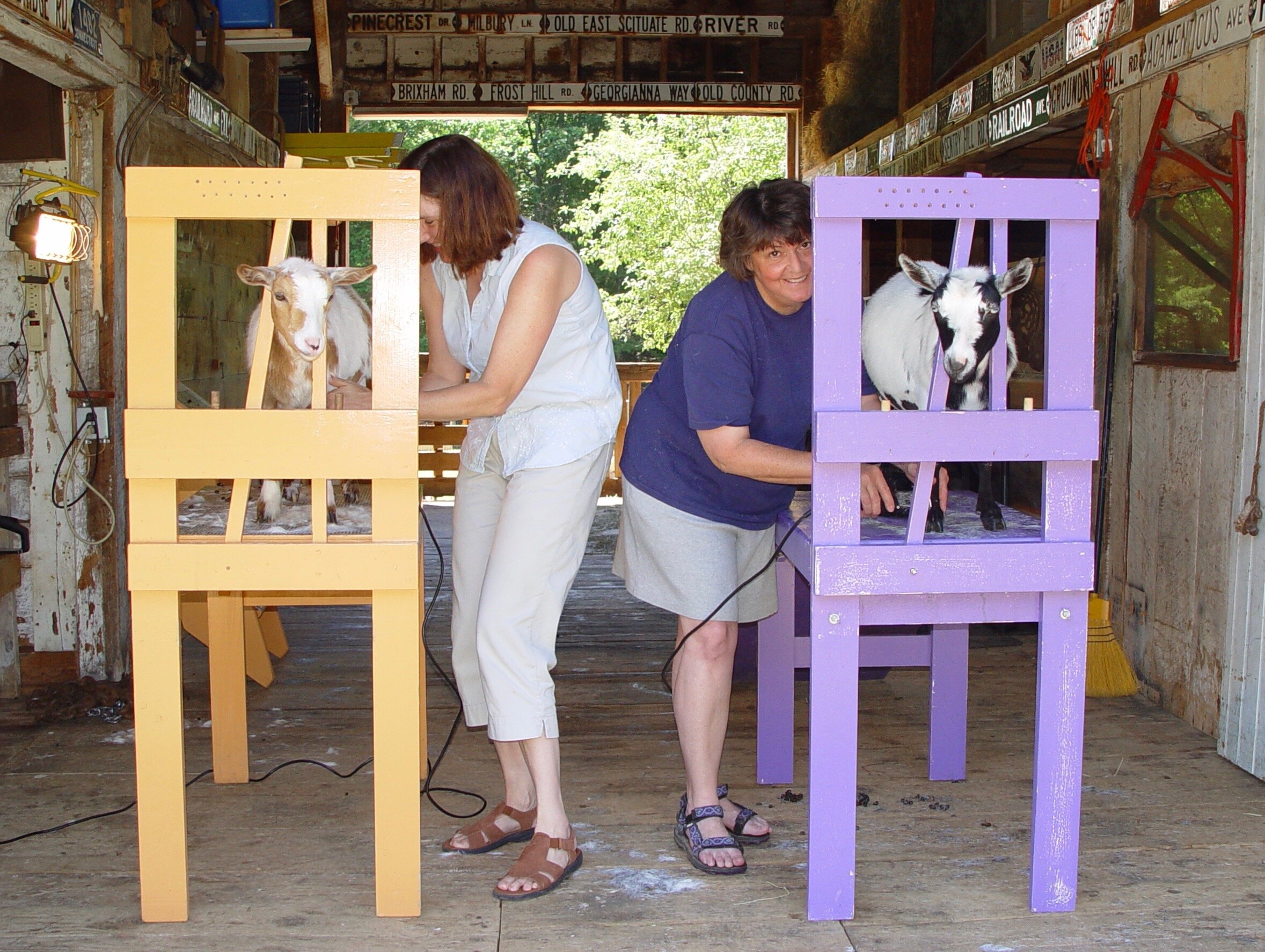health & Management…
“SG 4*M AR NC PromisedLand MG Frenchy 4*D AR 2160OH” peeking out the stall Door window
Our herd's foundation is built on many of the most influential bloodlines comprising the Nigerian Dwarf Dairy Goat breed and just as always, we are breeding for well conformed animals that show AND milk!
Wyl Cuddling one of Old Mountain Farm 2Spot’s wether kids. March 2004
For a few years our herd was sixty to seventy strong with a temporary population explosion happening in the spring during each kidding season. We felt at the time that this was two many goats to live with long term. However we had the good fortune of purchasing three entire herds owned by breeders who had become our friends. Because we had mentored those breeders,, we were comfortable with their herd management We feel grateful for the opportunity they gave us when their lives led them down a different path.
Newborn Old Mountain Farm Glissando cozy and warm with his dam Old Mountain Farm KalkaskaSand wrapped around him.
We were very excited to add our friends herds to our own herd because it gave us the opportunity to work with some Old Mountain Farm genetics that we thought were lost to us. As we studied our herd additions, we knew we needed to do some slow and thoughtful cuts to our herd. Cutting down on the amount of goats in our herd was done between 2010 and 2014.
Cheryle with Old Mountain Farm Sea Smoke. August 2008
Since that herd reduction, the Old Mountain Farm herd’ head count has stayed at under forty. It is our goal to stay within that self imposed limit of under forty herd members so that we can always enjoy spending time with our goats and truly enjoy their company while providing them with some one on one attention. We are still very passionate about our “Hobby Gone Mad” but it is necessary that the experience continues to evolve.
“Mynx” and “Old Mountain Farm JustPlainEd” making introductions.
Our goats are cared for with stringent health and management issues in mind allowing them to reach their full potential and of course we give them lots of love and attention. We spend time each day "Goat Gazing", so that we know our goat’s "normal" daily behavior. Familiarity with their normal routine means health issues are noticed before becoming a big problem. We try to combine “Goat Gazing” with our “Coffee Break”, especially during good weather when It is such a pleasure to sit with them in their pasture. Of course sometimes it means having to fight off a few persistent coffee loving goats.
“SG ++ B Old Mountain Farm Stag VEE 88” browsing in the Buck’s woodland Pasture.
Our entire herd is fed, free choice, Atlantic kelp meal, ZinPro, and Sweetlix loose minerals. Our goats are given a good quality orchard grass hay ensuring they have the appropriate amount of long stem roughage in their diet. We also provide sodium bicarbonate which acts as a rumen buffer to thwart off any serious digestive issue. They hardly ever eat the sodium bicarbonate but goats are smart and know to lick some if they have an upset stomach.
Summer 2017
The goats get fresh well water with a splash of apple cider vinegar daily, (piping hot during cold weather) and we increase hay and grain rations during cold weather to help them maintain warmth and proper conditioning. Milkers also get powdered yeast in their living area inside the barn.
“Old Mountain Farm PartiCrashah”
During good weather all goats have access to large woodland pastures where they love snacking and exploring. One of our favorite things to do is to just sit on a rock or in a lawn chair while watching the goats glide around their pasture. I never grow tired of their elegant beauty which means I am often found following them with my camera.
Cheryle & Raimy Quinn. Summer 2018
Does are mob fed a mix of Blue Seal EZ Pells, black oil sunflower seeds, steamed flaked barley and regular oats once a day. From that mob feeding our milkers are pulled in order to milk them one at a time. While they are on the milk stand, they are fed alfalfa pellets, sunshine pellets and flax seed.
“Old Mountain Farm Knight Storm’s milk covered lips”
We've been testing our herd for CAE (Caprine Arthritis Encephalitis), TB (tuberculosis) and Brucellosis since 1989. We also have, since 1989, made a point to test new goats entering the herd for CAE, CL & Johnes before releasing them from quarantine. In 2005 We added whole herd Johnes Disease testing and In 2007 we added whole herd CL (Caseous Lymphadenitis) testing to our regular biosecurity panel of tests.
Left to Right: “Old Mountain Farm PensLLegPNut”, “Old Mountain Farm Fat Tuesday” and “2*M Old Mountain Farm Anahita”
For a few years in addition to Johnes blood testing we added spot fecal testing. We now rarely bring goats into our herd from other farms but if we do, it is only from farms that practice a similar style of management as we do and it is generally only a goat that originated from our herd.
Our 2nd goat bus. We had lots of fun with this. Wyl painted it inside and out. Summer 2003
Years ago, after blood testing our goat’s and learning that they were copper deficient, we started bolusing them. It has been a slow learning process as we never wanted to give too much copper. We have found that each goat's needs are different so rather than having a set bolusing schedule, we bolus each goat based on conditioning. Some of our goats require it once a year, others require it more often.
SG 1*M Old Mountain Farm Mila Quinn VEEE 90 in labor and waiting to meet her new kids.
Weaning aged kids leaving for new homes, have been treated for coccidia and worms, received a CD&T vaccination as well as a supplemental Bo-Se (vitamin E/selenium) injection. We disbud and tattoo our kids between the ages of three to ten days of age. Doing so at this very young age prevents scurs and is more humane than waiting until kids are older since the younger kids are more resilient.
“SG 2*M AR Old Mountain Farm Ta-Dah! VEVE 90 “getting some love from “3*M AR NC PromisedLand MG Mizi 5*D AR”
We feed Blue Seal feeds and think that their products are superior to any other brand that we have at our disposal. We would like to feed an organic grain but have only found one brand that is both organic AND soy free. It is produced in VA and we do not have an affordable means of getting it here to us. We are looking forward to the day when our local feed dealer starts carrying that brand of feed.
A meditative Stag (with pumpkins) on A beautiful fall day.
The buck’s grain contains ammonium chloride which is the most important ingredient to ensure urinary tract health. It helps prevent and break up urine crystals. A buck’s pizzle (end of the penis) is so small in diameter, that crystals leading to blockages are a much bigger threat to bucks than they are to does. All of our goats get vitamin B and vitamin A&D injections at the tail end of every winter. Because we live in a seriously selenium difficient area of the country we give them Bo-Se injections four times a year including once pre-breeding and once pre-kidding. When we do our monthly maintenance, if a goat is not scheduled for a Bo-Se injection then we give them selenium/vitamin E oral gel.
“Old Mountain Farm Parti Favah VEEE 90” Looking beautiful out in the doe’s woodland Pasture.
Combination dam raising/bottle-feeding is our favorite kid rearing method (although some years we choose to strictly bottlefeed). Combination feeding creates well socialized “bomb proof” kids. However, since they are raised in the herd by their dams they develop strong immune systems. Another plus to this rearing method is that it does not produce the needy, bratty behavior that is associated with a lot of kids that are strictly bottle fed and the dams learn to love their “Kid Free” time.
Our friend Nancy (and her friend Cathy) body clipping goats in preparation for a show. Summer 2003
Wethers are castrated before leaving regardless of age. The theory that waiting until an older age before wethering prevents urinary calculi is just that…a “Theory”. I’ve only found one study done in Africa with a very small group of goats. Such a small study can not be taken seriously when there are so many variables involved.
Does browsing behind the barn. July 2003
We’ve been wethering goats for decades (some as young as under two weeks of age) and are aware of only three wethers born here who had urinary calculi. All three were goats living with new 2Legs that did not follow my feeding instructions. Improper diet is the one known reason for urinary calculi. Wethering the animal before it leaves assures us that only animals we deem worthy of breeding will be bred.
Old Mountain Farm goats receive a monthly “physical” which is when we peruse their personal medical record to see what they are in need of. It allows us to keep accurate, up to date individual records. When Old Mountain Farm goats move to their new home they are always accompanied by their detailed record of previous medical care and maintenance with a promise from us to be as helpful as possible in the future should the goat's new owners need mentoring. We feel very fortunate to have made many friends over the years, due to this continuing level of involvement with goats leaving our farm. We love being a part of the goat community and are grateful for our lives being enriched by our goat adventure!



















